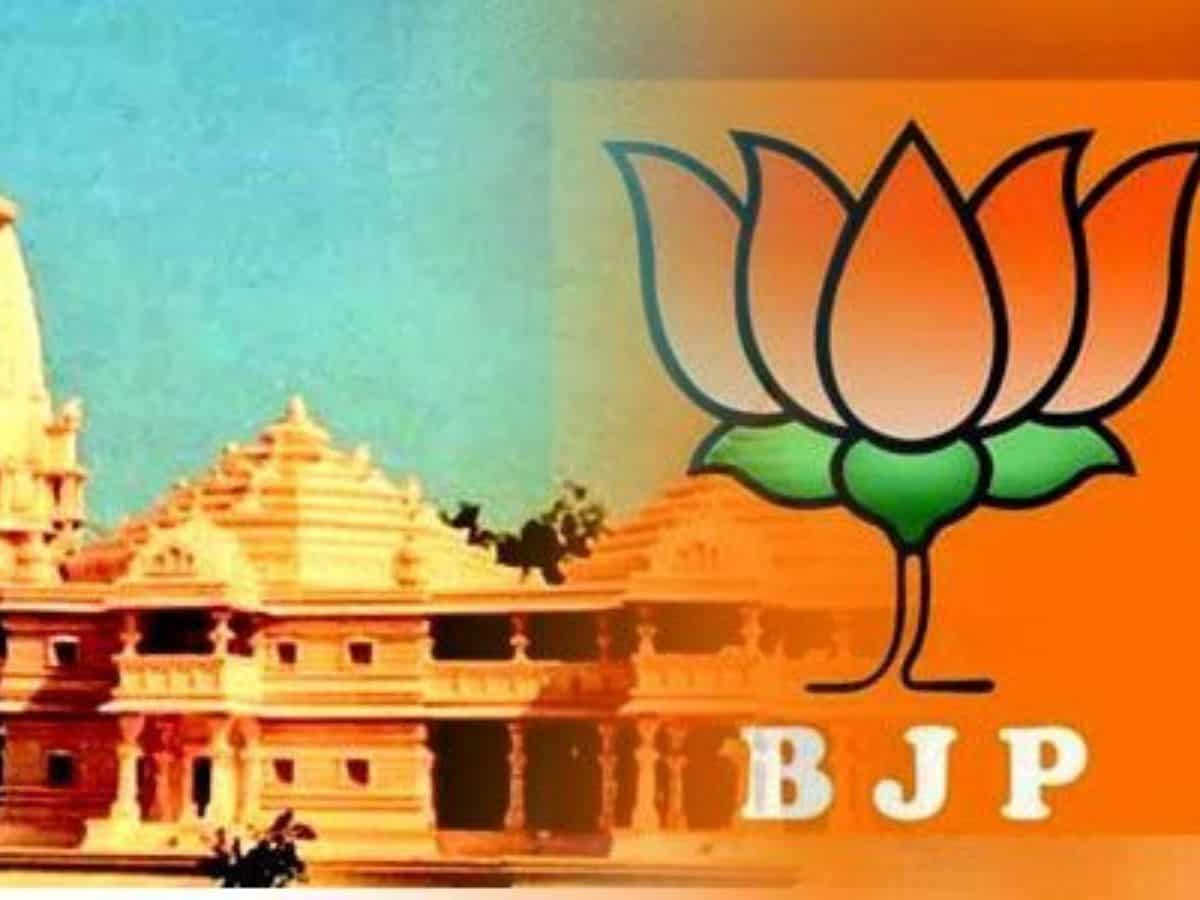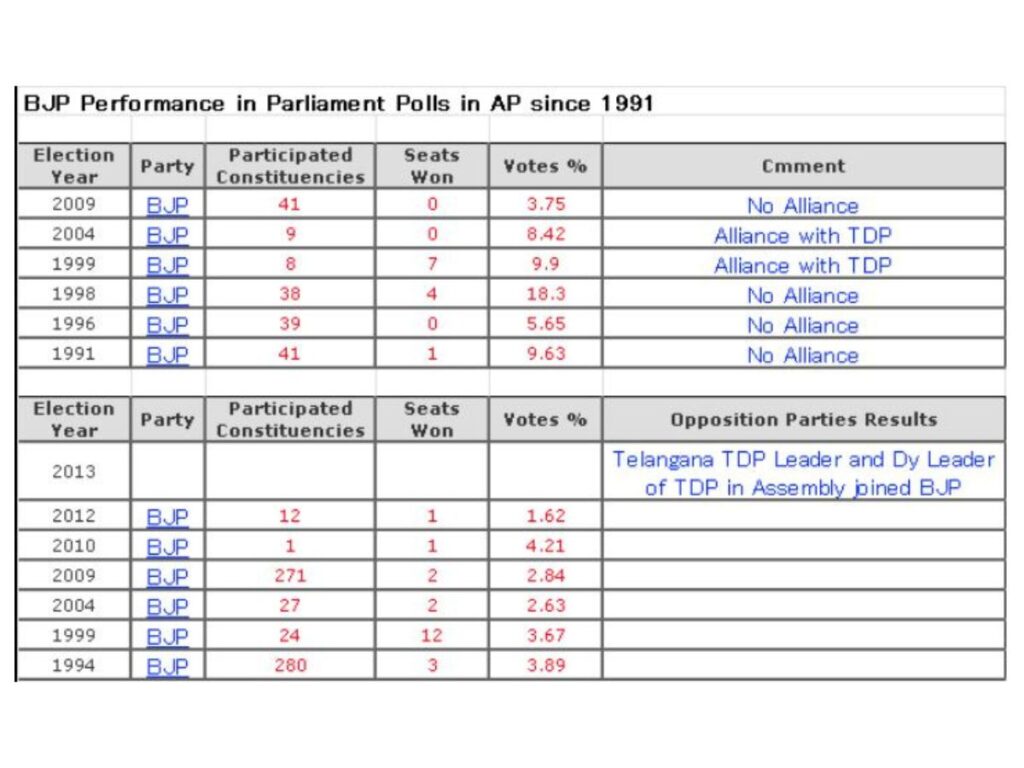
Hyderabad: The Bharatiya Janata Party (BJP) is banking heavily on Prime Minister Narendra Modi’s popularity and the saffron shades of Lord Rama’s idol installation at the Ayodhya Ram temple, hoping that its impact will make its way into previously unexplored areas in Telangana. The party is also looking to eat up political space held by the Bharata Rashtra Samithi (BRS), which has been on a downfall.
Over the last few decades, the BJP in Telangana and Andhra Pradesh (AP) has not been able to grow as fast as it would have liked to. Whether it was the downfall of the communist parties, the rise of BRS, or even the religious upheaval in society marked by the BJP’s rise at the Centre, the saffron party has missed the bus repeatedly in terms of expanding its base.
Essentially, in spite of political vacuums being created once in a while during elections, in Telangana and the erstwhile (joint) Andhra Pradesh state, the BJP’s rise has been slow. It was only since the 2019 Lok Sabha elections that the BJP in Telangana had some success. In Andhra, the BJP it currently at its lowest, thanks to the people blaming it and the Congress for bifurcating the state.
However, the alliance with Telugu Desam Party’s (TDP) and Jana Sena Party (JSP) in Andhra, the BJP is likely to win a few Lok Sabha and Assembly seats this time around. Telangana goes to polls on May 12 for the Lok Sabha elections, while in AP, the Assembly elections will also be held simultaneously along.
Ayodhya movement and BJP’s rise in Telugu-states
Even though the Ram Mandir issue (before it was built) in Ayodhya (Uttar Pradesh) has been the foundation on which BJP has grown, it did not give it the impetus in Andhra and Telangana to get established even in the 1980s and early 1990s. A look at BJP’s performance in the assembly before and after bifurcations shows that it has not had the best fortunes, and has hence always relied on alliance partners. It is only in Telangana that post bifurcation that the BJP has grown.
In the AP assembly elections in 1989, BJP had a vote share of 1.78 % with 5 out of 12 candidates winning as MLAs out of nearly 300. The party had not secured a single MP seat in the Lok Sabha elections that year. However, in 1991 general elections, former union minister Bandaru Dattatreya became the lone MP from the erstwhile AP comprising 42 Lok Sabha segments, when he was elected from the Secunderabad seat. The party’s vote share was 9.63 %.

That was the height of the Ram Janmabhumi movement when LK Advani’s Rath Yatra was already taken up. Despite the communal tensions running high during that period after the demolition of the Babri Masjid on December 6, 1992, the party was still able to get only 3 seats in the legislative assembly in the erstwhile AP in 1994. This showed that in spite of communalism, the BJP was still unable to get stronger.
The BJP scored a duck in the 1996 general elections, as its vote share had come down to 5.65 %, but got a major boost in the 1998 general elections as it won MP seats from the erstwhile AP with an 18.3% vote share. That was largely attributed to the party’s resurgence under the leadership of former Prime Minister Atal Bihari Vajpayee. Among the elected MPs, 2 were from the Andhra region, and 2 from Telangana.
It was only after allying with the TDP in the 1999 AP Legislative assembly and general elections that the party scored its best. It won 6 Lok Sabha seats and 12 of its candidates became MLAs. Out of the 6 MPs, three were from Andhra and the other three from Telangana.
That was the saffron party’s performance when the Ram Mandir movement was at its zenith. After the 2004 general elections, the BJP did not make much progress, except having a few MPs getting elected from either of the states. However things changed in 2014 after Telangana and Andhra Pradesh were bifurcated.
From dormancy, to a revival of Ram Mandir by BJP
Then the political narrative in the state changed, and the Telangana statehood movement eclipsed everything else till 2014, when Telangana was bifurcated. The BJP initially was unable to gain much.
While the K Chandrasekhar Rao (KCR)-led BRS won the 2014 Assembly polls with 63 seats in Telangana, the BJP and TDP in alliance won five and 15 seats. In the subsequent elections, the TDP joined hands with the Congress, and the BJP contested alone but managed to win only one Assembly seats with a 7% vote share. The BRS had won the 2018 state polls with a thumping majority of 88 out of 1119 seats.
However, just a year later things changed. In the 2019 Lok Sabha polls, the BJP managed to increase its vote share to 20% and won four seats, while the Congress and BRS won 3 and 9 seats each. The All India Majlis-e-Ittehadul Muslimeen (AIMIM) retained its Hyderabad seat, which it has been winning since 1984.
KCR, BJP and the 2023 Telangana polls
In 2019 Lok Sabha elections, a statement made by then Telangana chief minister KCR, referring to BJP’s saffron foot-soldiers as “Bondus” during an election campaign in Karimnagar cost the BRS dearly. It ending costing the BRS a reduced vote share, which was the reason behind BJP’s jump in vote share to about 20%, much higher than he 7% it got in the 2018 state elections.

In 2023, the Congress however managed to edge out the BRS and won the Telangana state elections with 64 seats. The BRS secured 39, while the BJP scraped away with 8 MLAs with a vote share of 13.90 %. This was however a significant jump from its 6.98 % in 2018 assembly elections.

Ram Lalla’s consecration in Ayodhya and BJP’s image
The inauguration of Ayodhya Ram Mandir and Ram Lalla’s “vigrah pratishthaan,” and the spectacle created around it across the country, did manage to percolate into every village and every household of rural Telangana during the last few months. That is what the party has been banking on heavily during the present 2024 general elections.
Even in areas where Hindutva forces couldn’t enter earlier, the BJP has been able to create some foot soldiers, if not many. “Akshinthalu, Prasad, Calendars” and other religious paraphernalia were delivered to every household even in the rural areas over the last few years. Writings on temple temples, bus stands, and the pictures of local BJP leaders welcoming Lord Ram to descend on earth along with PM Modi’s large image are now common sightings in villages and cities alike.
The effort put in by BJP by establishing booth-level committees and engaging with the people through various planned activities since its preparations for the 2023 assembly elections, has created a platform to infuse feelings of Hindutva and nationalism among the youth, especially those between 18 and 35 years of age.
“The BJP which was earlier restricted to urban areas, has now entered even into the areas where there has been a strong communist presence for generations where no BJP could dare enter a decade ago. There has been an effort to elevate Modi as the person who made the Ayodhya Ram temple a reality. Even those who have never known Modi, now know who he is,” Habeeb Quadri, a native of Nagarkurnool district and founder of Muslim Students Organisation tells Siasat.com.
His village which used to be a traditional stronghold of CPM, has gone from ‘red’ to ‘saffron’ in recent times. However, a recent survey by CSDS Lokneeti has predicted that BJP could gain only 2% vote owing to the completion of construction of Ayodhya Ram mandir.
In the 2024 Lok Sabha elections, the fight is primarily perceived to be between the BJP and Congress, in some of the Lok Sabha segments. For instance, the people in Siddipet district are viewing the general election as a fight primarily between BJP and Congress to claim the Medak Lok Sabha seat, which is a major deviation from the segment being a BRS stronghold over the last few decades.
How Telangana intellectuals see the rise of BJP
“Even when the Ayodhya movement was at its zenith, BJP wasn’t able to grab power in Telangana. How can they do it now,” Mahabubnagar MLA Yennam Srinivas Reddy had wondered when he was the vice-president of BJP before joining the Congress and winning 2023 assembly elections with a huge margin.
He had won as Mahabubnagar MLA from BJP in 2010 by-election to the seat, and had served as the district president of BRS (then TRS) before that. He believes that BJP has failed to understand the pulse of the people of Telangana.
Political observers feel that some chunk of the pink party’s vote bank could drift either towards the BJP or Congress, depending on the local factors and local faces in the poll fray in the coming Lok Sabha elections.
Professor E Venkatesu, professor in the department of political science, University of Hyderabad, told Siasat.com, though it is true that BRS has weakened in recent times, and its vote bank has split between Congress and BJP. “The electoral performance of BJP is based on BRS’ political stand, as it will still play a crucial role in the general elections. BRS has lost almost 10 % of its vote share, going from 47% in 2018 assembly elections, to around 37 % in the 2023 assembly elections.
“Nine candidates of BJP were earlier in BRS and are those who lost the assembly elections. But they still have some base, the reason why BJP fielded them. To what extent Modi factor will play a role is not very clear, but going by the 13.5 % of vote share it received in the assembly elections with 8 of its candidates winning, it is possible that BJP could expect a considerable number of seats,” he opined.
He does point out that even without the temple issue, BJP had won 4 MP seats in the 2019 general elections. “The Congress is sweeping north Telangana. In the south, voters have shifted from BRS to BJP and Congress. But in central Telangana BRS could hold its ground. But in the Lok Sabha elections it is certainly challenging for the BRS,” felt Dr Venkatesu.
BJP spokesperson P Kishore Reddy says that BJP is not going to elections just based on one issue which is the Ram Mandir and that the entire campaign including the development, welfare, national security, dealing with terrorism and left-wing extremism, economy and other aspects will come into pay in the general elections.
“Fundamentally we are reducing BJP to a one-point party, which is the Ayodhya movement party. But it is no longer a simmering issue, and after the elections it won’t be an issue anymore. Can you name one candidate or a leader who joined the BJP because of the Ram Mandir issue,” he asks.
“The electorate has clarity on the issues in the assembly elections, and the Lok Sabha elections. Those candidates who have lost the assembly elections but have been fielded by the BJP in the general elections, can’t be treated as those primarily rejected by the people,” he underlines.
However, being cautiously optimistic, Kishore submits that wherever the organisation has been strong, the party will make a visible impact, and it could get anywhere between eight to 12 seats in the coming general elections in Telangana.
Whether it is Telangana Chief Minister Revanth Reddy’s strategy, or Modi’s charisma coupled with BJP’s attempts at reviving the spirit of Ayodhya movement in the rural areas of Telangana, June 4 will tell how deep the BJP’s saffron hue has gone in the state.
